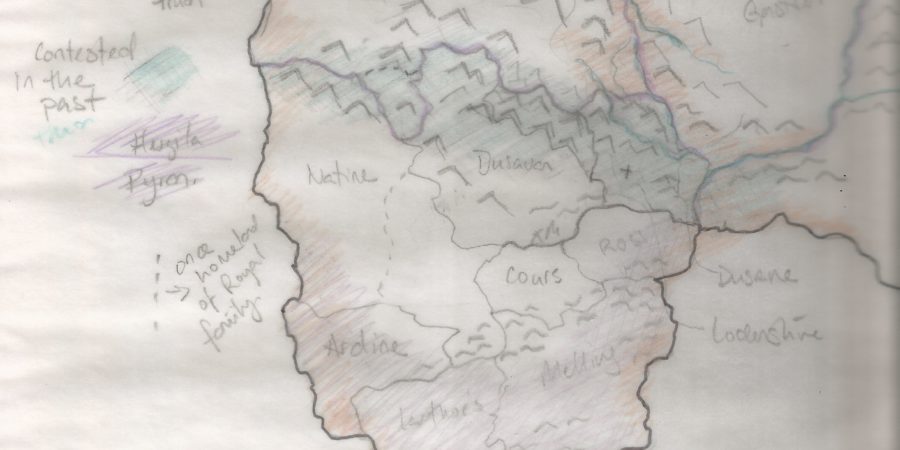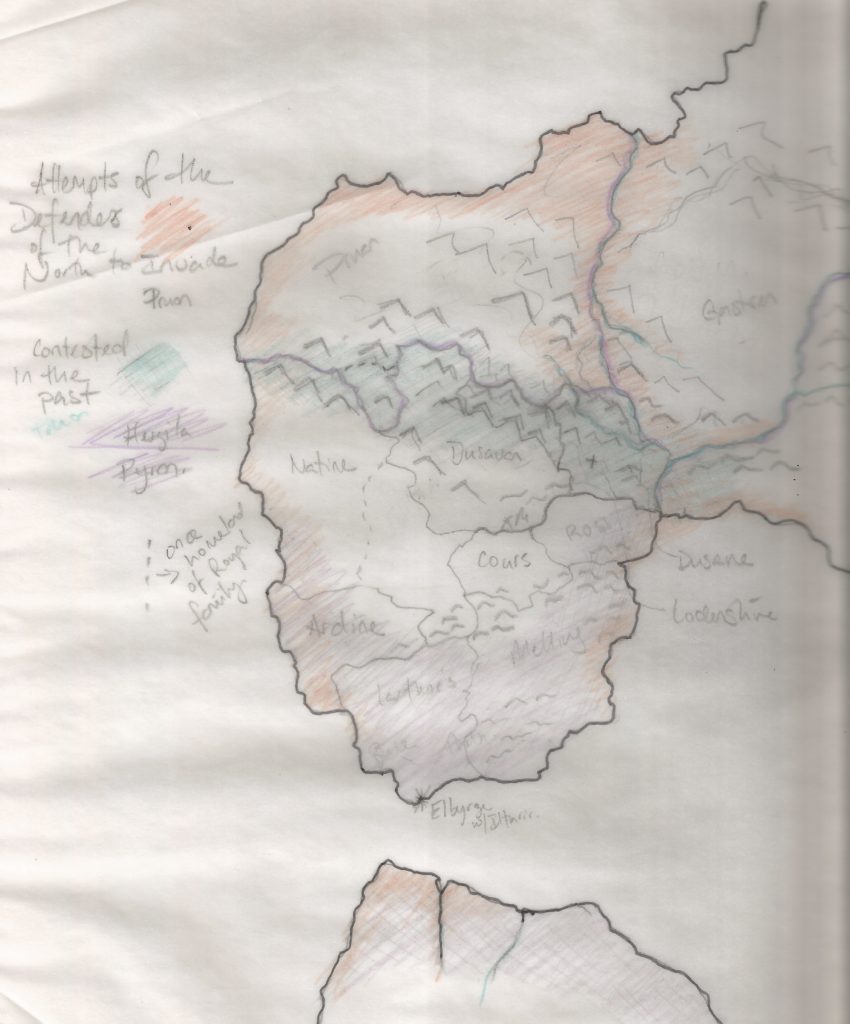It’s true. My characters are not Caucasian. This is going to be true no matter how you slice it, because, well… they’re on an entirely different planet for one. With all the various cultures that I’ve crafted in building this world, most of them have not been inspired by Europe for another. If Europe is part of it at all, it’s still not the driving mythos, history, or culture.
Maybe I grew up perfectly poised on the knife edge of Europe being far too familiar to become uninteresting, especially with my colonial background times two. Everything on the other side of that is far more interesting no matter how far back I go. Sumerian myth combined with Chingis Khan’s childhood, or a brief passage about the origins of Kali combined with ideas of death in oriental cultures, burial practices of different cultures, Siberian shamanism, Ndembu healing rituals… Those are the kind of cultures that spark my reaching for these new cultures of Ihyel.
Only in The Bone Reader books do I have more European leanings, but the basis of the Pyrannian culture is Moorish Spain, not Merry Old England. Some of the older bones of the first book, however, certainly are based on the latter. That is thanks to discussions with author Kathryn Hinds, of blessed memory. Her books on life in the Middle Ages, mainly Castle Life, but also Life in the Medieval Muslim World, which despite being for middle grades were quite informative.
That said, I do find it a bit sad that there are still so much of its European bones within its culture. It feels rather like a cop out. As far as fantasy cultures go, it’s just so easy to do. The way “world history” is taught in schools, one would think there was only one culture to the world. There are times I knew that the culture in The Bone Reader didn’t grow as vibrantly as other cultures I crafted feel to be. The ideas of the four humors, for instance, didn’t inspire me as much—it was as if the culture kept in its box of motivation rather than growing forth from it. It remained locked within the confines of this world, rather than becoming something of its own in Ihyel.
(Be warned… this may be changing because of the two new books–one drafted, one in the midst of being drafted!)
Regardless, I had to respect that books past as the sequels grew in strength. Considering I went beyond the walls of Ilturir, and far more north—unexpectedly!—I had more culture crafting to do. Respecting those bones of the culture I’d already crafted was something I had to do.
Currently working on the third Bone Reader Mystery, Ghost Bones, I was trying to look for some videos on medieval or even Tudor life, and stumbled across a video about Queen Elizabeth I’s make up routine. Still having to work on the research for the second book, Servant Bones, I realized there was a scene were cosmetics and a beauty routine would work wonderfully.
Cemirowl, bless her peasant based heart, would probably find this as tiresome as I do. A new character would not. The video was interesting.
I had to stop around the whole lead based foundation, because I realized it wasn’t helpful to what I had in mind in what I might “discover” about cosmetic routines of a typical Pyrannian woman, and I realized I really wanted to know. Again, this goes back to the fact that most of the cultures in Ihyel are not Caucasian.
Neither the Roman nor Egyptian videos on makeup or beauty were helpful. There was a fascinating video on Organic Make Up Used by Indians in Ancient Times. The sound went out throughout most of it, but what I could see was absolutely interesting! I thought it very interesting to read through a number of different articles that with Ayurvedic medicine and cosmetics that if you can’t eat it, you ought not put it on your skin.
When I would try to research darker skin tone histories of cosmetics and skin foundations it would invariably launch me back to Egypt. I thought this curious. The ideals of a paler skin still seemed like the European stance of superiority. That was not at all what I was looking for. Even an article about the A-Beauty genre mentioned a product that had women lightening their skin. I found this frustrating.
There is a culture of very pale skinned, almost white haired people on Ihyel. The stories where they come up aren’t published yet; and the more intriguing ones (to me) only have framework scenes in my journal. In that they’ve re-emerged from some other continent on the heels of a super volcano explosion causing worldwide famine, so they’re considered the harbingers of death and often called white wraiths, without any kindness. There’s a vivid scene where they have arrived pale, sunburnt, skin peeling before the year without summer. (It was, I’ll admit, a surprising scene to write, and I have reasons to NOT write it till I know I’ve handled the culture I’m crafting with respect to that which inspired it).
The more I write different cultures the more I learn about them. The White Wraiths, or Defenders of the North, are considered by most of the primary cultures I write about to be an antagonist culture—not because they’re colonial, but because they are raiders. One book (which looks to become two) does have an Inuit background, and a land based Viking culture in its background. However, unlike this antagonistic culture, these peoples who didn’t raid. The earth based culture that inspired them were mercantile in its history, thriving down the Rhine, down to the Danube far past western Europe into Eastern Europe portaging all the way down to the Black Sea. While there was some raiding along those routes, the were communities along these riverways that thrived because of trade more than violence—something I had not known, and was thus inspired.
That said, the ideas of fairer skin being valued seemed rather awful. I uncovered an article about “Beauty and the Bleach” and was staggered by how many skin bleaching products are considered toxic; there is a great deal of information about it’s a trend with roots in white privilege. I can believe it. Only in the article mentioned above about A-Beauty, African Beauty, did I see a picture of a woman with red henna covering her face, giving the woman not a lighter tone, but a glorious ruddy tone. It harkens back to ideas that henna is good for the skin. Looking at Egyptian eye makeup, it was often used for protecting the eyes from not only evil, but against infection.
The more I read, and watched the more I realized that there was an idea of paleness being proof of wealth. If you’re not going out into the fields to work, you’re going to be paler. Then it hit me: Where did the idea of being TAN become popular?
(An aside: This comes with the corollary of lead paint making you virginally white destroying your skin—not only because of the lead to slowly poison you, but because of the borax was added to the mix has a tendency to degrade the skin as well. Besides Queen Elizabeth’s smallpox scars, by the time she was older they had to really slather it on—using the degrading-the-skin product to cover up the degraded skin. Swing to the other side: Tanning does the skin no favors as well! It not only degrades the skin, aging it faster, but offers cancer as a side gig.)
Popsugar has an article on why tan skin was associated with beauty. Again, it went back to the ideas of wealth: when Coco Chanel went on a yacht cruise and came back tan. If you had money enough for leisure, you could get gloriously tanned—well, apparently sunburnt. The sunburnt red necks of the yeomanry leaning into gathering your crops becomes desirable when it covers the body? Being baked because of labor vs being baked because you’re lying on a yacht?
One take away I got was that the cultures where cosmetics were more about beauty and healthy skin didn’t inspire products that clog the pores, damage the skin, and focused on improving the quality of what one was born with. Excepting the egg white primer in the Queen Elizabeth, which I will absolutely try, especially cleaning my skin with rose water, I can only see that beauty was for the west often quite destructive to the skin and any natural beauty. Even historical Roman makeup where a natural look was prized used, again, that dratted lead based foundation, and would often add a unibrow to prove the naturalness of a look—by some historical accounts. (I found this absolutely fascinating, myself having such thin eyebrows that look almost nonexistent). Right. Let’s use toxic materials on our skin to prove how natural our beauty is?
Bleah on that! In my daily life I’m far too much a wash and go type of person. Excepting special events—or photo shoots where my photographer actually knows how to put on makeup! Thank you, Fox—I tend to feel very much inadequate in application. I now know my characters suffer for it. I do know that fashion can illuminate culture, but I prefer to look at the foods that are grown, the trade they would do to get more exotic ingredients. This I am, apparently, going to change, because….
What to do when I finally write and meet a girly girl?
Go down this rather interesting rabbit hole. The long jaunt into all this was because I became curious on how a Pyrannian woman would make herself beautiful. Colonialism, fortunately, wouldn’t be a factor. Only wealth would be. The fact that my cultures aren’t Caucasian would also be a factor. Privilege is a factor, but it will have to be Ihyel style. In Servant Bones that would decidedly be an interesting cultural cue, and the subject becomes actually interesting.
Where will this all lead? Well, when Servant Bones comes out, and even Ghost Bones comes out, you’ll be able to see where!
Added references:
These reminded me of trade, and how glass was traded extensively, among other very interesting things.
https://www.youtube.com/watch?v=toInJlUrYnc (LOVE this one).
https://www.youtube.com/watch?v=9AxHoNCFHXA (Also informative)
https://www.youtube.com/watch?v=ss7yriPaNf4 (Quite interesting)
https://www.girlmuseum.org/more-than-pretty-tudor-england-1485-1603-ce/ (Offered details)

